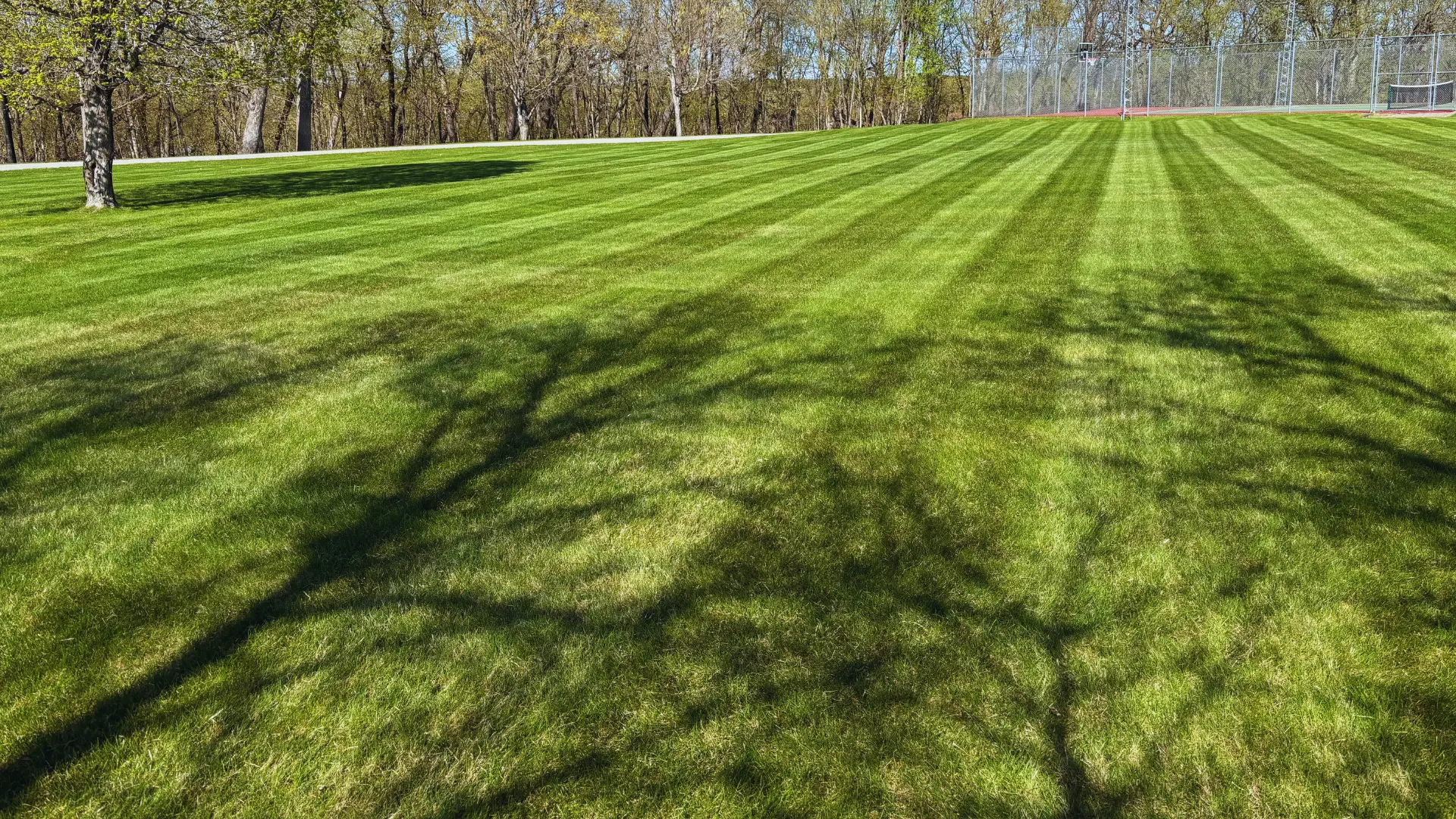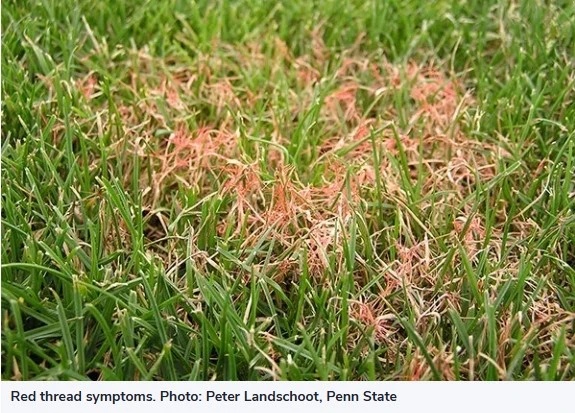
Hello neighbors!
With the recent stretch of hot and humid weather, you might be noticing some unusual spots, colors, or textures showing up in your lawn. While it’s easy to blame insects or drought, you could be looking at a common turfgrass fungus.
Fungi are a natural part of any lawn's ecosystem, but under the right conditions—like the heat and humidity we’ve been experiencing—they can multiply and become visible, causing aesthetic damage or, in some cases, serious harm to your turf.
These fungi primarily affect the blades of the grass, not the crown or the roots. While they can look alarming, they rarely kill the grass and can often be managed with good cultural practices.
If you see irregular, pinkish-red patches on your lawn, you might have Red Thread. Upon closer inspection, you'll notice red, thread-like strands extending from the tips of the grass blades.

What it is: A foliar disease that is most common in the cool, wet weather of spring and fall.
Threat Level: Low. According to the University of Minnesota Extension, Red Thread is a cosmetic issue and does not harm the roots or crown of the plant. Lawns typically recover.
Key Cause: A primary cause is low nitrogen fertility. If your lawn is under-fertilized, it's more susceptible.
Treatment: The best control is proper fertilization. A balanced fertility program usually ...
Are you frustrated with your old sprinkler system? Do you see it watering the lawn during a downpour, or worry about your landscape's health when you're away? It's time to stop wasting water and start watering with intelligence. The Hunter Hydrawise irrigation controller is a game-changing upgrade that will save you money and give you a healthier, more beautiful landscape.
Many people think a rain sensor makes their system "smart." But a traditional controller with a rain sensor is only reactive. It shuts off your sprinklers after it has already started raining, and it has no idea what the weather will be like in an hour.
The Hydrawise controller is truly proactive. It doesn't just react to past rain; it uses a "Virtual Weather Station" that pulls data from satellites, local weather stations, and atmospheric data to know what the weather will be like at your specific location. It's like having a personal meteorologist for your lawn!
Predictive Watering Saves You Money: By analyzing local weather forecasts, the Hydrawise system knows if rain is coming and will skip the watering cycle before it's needed. This proactive approach is how it can save you up to 50% on your water bills compared to a traditional system.
Control from Anywhere: With the user-friendly Hydrawise app on your smartphone, tablet, or computer, you can manage your...
Here in the Detroit Lakes area, our oak trees are a cornerstone of our local scenery and the pride of our properties. Across the beautiful landscapes of Otter Tail and Becker counties, these majestic trees provide shade, beauty, and value. But they also face serious threats, including our tough Minnesota climate, compacted soil, and damaging insects.
At Miller Yard Care, we have a tool to protect your valuable oaks: Plant Growth Regulators, or PGRs. It's a simple treatment with game-changing benefits for tree health. Let's explore how it works and why it’s a crucial service for keeping your oaks strong.
Think of a Plant Growth Regulator as a "smart supplement" for your tree. It’s a professional treatment that Miller Yard Care applies at the base of the tree down in the roots. The PGR works by signaling the oak to slow down its canopy growth—the leaves and branches.
But that energy doesn't just vanish. Instead, the tree redirects that energy below ground to its root system and into its own defense systems. It's a strategic shift that builds a healthier, more resilient tree from the inside out.
When an oak tree focuses its energy on its core health instead of just getting taller, the results are incredible. This is the professional oak tree care your Detroit...
Here in the Detroit Lakes area, our oak trees are more than just part of the landscape; they are majestic giants that define our properties, lakefronts, and wooded areas. From the mighty bur oak to the stately red oak, these trees are a cornerstone of our beautiful Minnesota environment. But a hidden threat is putting our oaks at risk, especially after periods of drought or stress. It’s called the Twolined Chestnut Borer, and it’s a pest every local homeowner should know about.
At Miller Yard Care, we're seeing an increasing number of oak trees around Detroit Lakes showing signs of decline. Often, the culprit is this destructive insect. The good news is that with early detection and proper care, you can take steps to protect your valuable trees.
The twolined chestnut borer (Agrilus bilineatus) is a native flatheaded wood-boring beetle. While it's a native insect, its populations can surge, particularly when oak trees are stressed. Recent drought years in Minnesota have created the perfect conditions for this pest to thrive, as stressed trees have fewer defenses against attack.
Information from leading regional institutions like the University of Minnesota Extension and the University of Wisconsin-Madison highlights that this borer primarily targets oaks that are already weakened by factors such as:
Drought stress
Construction damage to roots
Soil compaction
Storm damage
Birch trees are Minnesota favorites, but they have two major enemies that can cause serious damage. If your birch tree looks sick, one of these pests is likely the cause. Here’s what to look for.
This is the most dangerous pest for birch trees in our area. It works under the bark, cutting off the tree's life supply.
Look for these warning signs:
Thinning Leaves: The top of the tree starts to look thin and weak.
Dying Branches: Branches at the top of the tree begin to die and lose their leaves.
D-Shaped Holes: You might see small, D-shaped holes in the bark.
A Bronze Birch Borer attack is a serious threat to your tree's survival. Early detection is everything.
This pest won't kill a healthy tree on its own, but it weakens it significantly, making it an easy target for the deadly Bronze Birch Borer.
Look for these warning signs:
Brown Blotches: Leaves develop ugly, brown patches that look like blisters.
"Scorched" Look: The whole tree can look brown and scorched by mid-summer.
Early Leaf Drop: The tree may lose its leaves long before fall.
Spotting these symptoms is the first step, but a correct diagnosis is key to saving your tree. The only way to know for sure what’s wrong and...
Just complete the form below to get a pricing quote.
